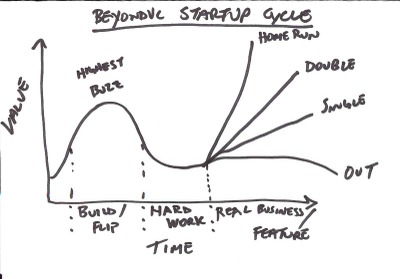Tis the holiday season and with the end of year comes budget planning for 2008. So that means it is time to get all of your key management members together to start reviewing 2007, what worked well, what did not work out, and to hammer out goals for next year. In the spirit of giving, I thought I would share with you one piece of advice – don’t sacrifice the long term value of your business for the short term. What it comes down to is how you allocate your dollars in your budget. Every dollar you spend in one functional area is a dollar taken away from another department. If you spend too much on sales today, you may not have enough in R&D and vice versa. It is careful when budgeting to think about 2008 but also to plant the seeds for 2009 as well.
Let me give you a few examples from recent meetings with portfolio companies or friends seeking advice. I was recently reviewing a 2008 budget and was quite excited about the bookings and revenue ramp that the management team had presented. However, as I dug into the model the one point I recognized was that it was all driven by additional sales headcount. That is ok, but what I did not see was any investment in building out our channel or OEM business. Granted, the management had to finely balance their cash spending with their revenue forecast, but my concern was that if we did not invest today to build for the future 12 months out, we would not have any sales leverage in our business. After discussion, we were in favor of sacrificing some near term revenue in order to get the key headcount to start building the channel and partnership model. Yes, these opportunities always take time to build, but if done right can help fuel rapid sales growth 12-18 months down the line. Without any upfront investment, the company was stuck with a 1:1 sales model meaning that bookings and revenue were directly correlated to each additional headcount.
Another example came from a breakfast meeting I had today. I was catching up with an entrepreneur I have known for awhile and getting an update on his business. We were discussing the various product lines at the company, and how each line was respectively performing. What was clear was that the market the company initially set out to conquer had become commoditized, and that his business did not diversify quickly enough to offset this trend. In other words, he said that while the company was doing well, his biggest regret was not investing enough in the future. Even though they saw their core market slowly dying, they milked the cash cow as much as they could but did not do enough to build new product lines. It was a classic case of "the exit is around the corner" where the management and board focused too much on prettying up the revenue growth and profitability lines at the expense of positioning the company solidly for the future. When the exits didn’t materialize, the team had to go back to the drawing board and start building out a new product line. If they had done that 2 years ago, they may have sacrificed some revenue but they would also be better positioned today.
So the lesson is both cases is to carefully balance your revenue goals with making the right level of investment for the future whether it be in diversifying your go-to-market strategy or building out a new product line. Yes, we live in a short-term world where every investor is focused on the next month or quarter, but it is imperative for any technology company to balance today’s needs with the future opportunity. I hope these examples spur some vibrant discussion amongst your management team as you put together your goals for 2008 while keeping an eye out for 2009.
 It represents the reality and the opportunity for wireless applications – the majority of people today only send SMS messages and a relative minority use their phones for mobile browsing, email, and other applications. Will easier to use phones, faster networks, and better applications change that? I am sure that it will as users like my wife and her friends who are not the most technically savvy are starting to get iPhones and using it to post pictures to websites and view Youtube videos on the run. However, in the meantime, I would also remember that the lowest common denominator is still SMS so don’t forget that user base when building mobile apps like community based functions, social networking, games, advertising, etc. because that crowd is still dominating the here and now.
It represents the reality and the opportunity for wireless applications – the majority of people today only send SMS messages and a relative minority use their phones for mobile browsing, email, and other applications. Will easier to use phones, faster networks, and better applications change that? I am sure that it will as users like my wife and her friends who are not the most technically savvy are starting to get iPhones and using it to post pictures to websites and view Youtube videos on the run. However, in the meantime, I would also remember that the lowest common denominator is still SMS so don’t forget that user base when building mobile apps like community based functions, social networking, games, advertising, etc. because that crowd is still dominating the here and now.